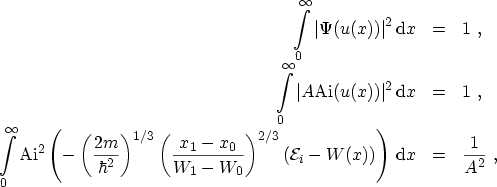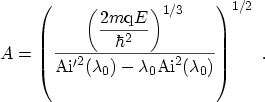C. Wave Function Normalization for a Triangular Potential
For the assumption of a triangular energy well, the wave function is
approximately given as (see Section 3.6.1)
 |
(C.1) |
with
 |
(C.2) |
The square of the wave function is a probability, therefore the normalization
can be written as [156]
 |
(C.3) |
where an infinite barrier is assumed for  .
With
.
With  ,
,  , and the electric field
, and the electric field
 |
(C.4) |
the integral becomes
 |
(C.5) |
Substituting
 |
(C.6) |
yields
 |
(C.7) |
Using the expression [157]
 |
(C.8) |
and
 the normalization constant becomes
the normalization constant becomes
 |
(C.9) |
A. Gehring: Simulation of Tunneling in Semiconductor Devices





